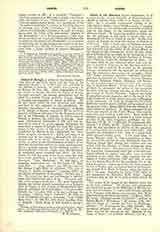

James of Sarugh, a writer of the Syrian Church, “the flute of the Holy Spirit and the harp of the believing church”; b. at Kurtam, 451, probably in the district of Sarugh; his father was a priest; d. at Batnan November 29, 521. Three biographies of him are extant in Syriac: the first by James of Edessa (seventh century), the second anonymous, and the third by a certain George, probably George, Bishop of Sarugh, contemporary of James of Edessa. We do not know where he was educated, nor when and how he was ordained to the priesthood. He became “periodeutes” or “chorepiscopus” of Haura in the district of Sarugh, whence in 502 he wrote to the city of Edessa, threatened by the Persians, and in 519 to the Christians of Najran; in 519 he became Bishop of Batnan, the chief city of Sarugh. Assemani (Bibliotheca Orientalis, I, 290 sq.) has endeavored indeed to prove against Renaudot the orthodoxy of James of Sarugh, but from this writer’s letters to the monks of the convent of Mar-Bassus (published by Martin in the “Zeitschrift der deutschen morgenl. Gesellschaft”, XXX, 217 sqq.) it is evident that he was always a Monophysite and continued such to his death. However, he took practically no share in the Christological polemics of his time and devoted his activity to study and literature. He is especially famous for his metrical homilies in dodecasyllabic verse of which, says Bar-Hebri us, he composed seven hundred and sixty. Of these barely one-half has come down to us, and a few only have been published, e.g. on Simeon Stylites (in Assemani, “Acta Martyrum”, II, 230 sqq.), on virginity, fornication, etc. (in Overbeck, “S. Ephriemi Syri… opera selecta”, pp. 385 sq.), two on the Blessed Virgin Mary (in Abbeloos, “De vita et scriptis S. Jacobi Sarugensis”, Louvain, 1867), on the chariot of Ezechiel (in Moesinger, “Monum. Syr.”, II). He wrote the first one (on Ezechiel‘s chariot) when only twenty-two years of age. His prose writings were comparatively few. The most important besides the letters already mentioned are a letter to Paul of Edessa of 519, a letter to the pantheist Bar-Sudaili published by Frothingham (“Stephen Bar-Sudaili, etc.”, Leyden, 1886, p. 10 sqq.), a liturgy (tr. Renaudot, “Liturg. Orient. Collectio”, II, 356), an order of baptism (ed. and tr. Assemani, “Cod. Liturg. Eccl. Univ.”, II, 309; III, 184), festal homilies (Ger. tr. Zingerle, “Sechs Hom. d. heil. Jacob v. Sarug”, 1867).
H. HYVERNAT

